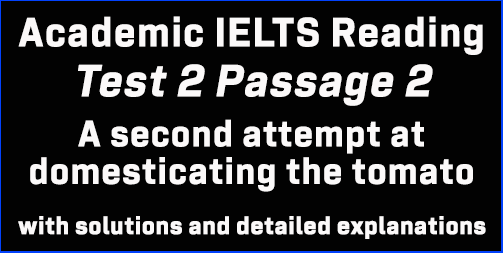Academic IELTS Reading: Test 3 Reading passage 1; Roman shipbuilding and navigation; with best solutions and best explanations
This Academic IELTS Reading post focuses on solutions to IELTS Cambridge 16 Reading Test 3 Reading Passage 1 which is titled ‘Roman shipbuilding and navigation’. This is a targeted post for IELTS candidates who have big problems finding out and understanding Reading Answers in the AC module. This post can guide you to the best to understand every Reading answer without much trouble. Finding out IELTS Reading answers is a steady process, and this post will assist you in this respect.
Test 3: AC Reading Module
Reading Passage 1: Questions 1-13
The title of the passage: Roman shipbuilding and navigation
Questions 1-5: TRUE, FALSE, NOT GIVEN
[In this type of question, candidates are asked to find out whether:
The statement in the question agrees with the information in the passage – TRUE
The statement in the question contradicts the information in the passage – FALSE
If there is no information on this – NOT GIVEN
For this type of question, you can divide each statement into three independent pieces and make your way through with the answer.]
Question no. 1: The Romans’ shipbuilding skills were passed on to the Greeks and the Egyptians.
Keywords for the question: Romans’ shipbuilding skills, passed on to, the Greeks, the Egyptians,
In paragraph no. 1, take a look at lines 3-4, “ .. .. The Romans were not traditionally sailors but mostly land-based people, who learned to build ships from the people that they conquered, namely the Greeks and the Egyptians.”
Here, the writer says that the Romans learned the skills of shipbuilding from the Greeks and the Egyptians, the skills were NOT passed on to the Greeks and the Egyptians.
So, the answer is: FALSE
Question no. 2: Skilled craftsmen were needed for the mortise and tenon method of fixing planks.
Keywords for the question: skilled craftsmen, needed, the mortise and tenon method, fixing planks,
We find the mention of ‘the mortise and tenon method of fixing planks’ in line no. 6 of paragraph no. 2. However, there is NO MENTION of whether they needed skilled craftsmen or not for those methods.
So, the answer is: NOT GIVEN
Question no. 3: The later practice used by Mediterranean shipbuilders involved building the hull before the frame.
Keywords for the question: later practice, Mediterranean shipbuilders, building the hull, before the frame,
In lines 7-9 of paragraph no. 2, the writer of the passage says, “ . . .. . Then in the first centuries of the current era, Mediterranean shipbuilders shifted to another shipbuilding method, still in use today, which consisted of building the frame first and then proceeding with the hull and the other components of the ship. .. .. .”
Here, another shipbuilding method = the later practice, building the frame first and then proceeding with the hull = building the hull AFTER the frame,
So, the answer is: FALSE
Question no. 4: The Romans called the Mediterranean Sea Mare Nostrum because they dominated its use.
Keywords for the question: The Romans, called, the Mediterranean sea, Mare Nostrum, because, dominated, use,
Lines 6-7 of paragraph no. 3 have the answer. Here, the author of the passage says, “ . . .. . Eventually, Rome’s navy became the largest and most powerful in the Mediterranean, and the Romans had control over what they, therefore, called Mare Nostrum meaning ‘our sea’.”
Here, the Romans had control = they dominated its use,
So, the answer is: TRUE
Question no. 5: Most rowers on ships were people from the Roman army.
Keywords for the question: most rowers, people, Roman army,
In paragraph no. 4, take a look at lines 4-5, “ . . .. It is worth noting that contrary to popular perception, rowers were not slaves but mostly Roman citizens enrolled in the military. . .. .”
Here, mostly Roman citizens enrolled in the military = most rowers . . . . people from the Roman army,
So, the answer is: TRUE
Questions 6-13: Summary completion with ONE WORD ONLY
[In this kind of question candidates are given a summary for one, two, or three paragraphs with some fill-in-the-blanks questions. Candidates need to find out the related paragraphs by correctly studying the keywords from the questions. Then, they should follow the steps of finding answers to fill in the gaps.]
Title of the notes: Warships and merchant ships
Question no. 6: Warships were designed so that they were _________ and moved quickly.
Keywords for the question: warships, designed, so that, and moved quickly,
In paragraph no. 3, the very first line says, “Warships were built to be lightweight and very speedy. …”
Here, Warships were built to be = Warships were designed so that, very speedy = moved quickly,
So, the answer is: lightweight
Question no. 7: A battering ram made of ________ was included in the design of attacking and damaging the timber and oars of enemy ships.
Keywords for the question: remained afloat, after battles, able to sail, close to land, lacked,
In lines 4-5 of paragraph no. 3, the writer says, “ .. . .. . They had a bronze battering ram, which was used to pierce the timber hulls or break the oars of enemy vessels. .. .. .”
Here, used to pierce the timber hulls = attacking and damaging the timber, break the oars of enemy vessels = attacking and damaging oars of enemy ships,
So, the answer is: bronze
Question no. 8: Warships, such as the ‘trireme’, had rowers on three different ________.
Keywords for the question: Warships, such as, ‘trireme’, rowers, three different,
In paragraph no. 4, the first lines say, “There were many kinds of warship. The ‘trireme’ was the dominant warship from the 7th to 4th Century BCE. It had rowers in the top, middle and lower levels, and approximately 50 rowers in each bank. .. .. .”
Here, the top, middle and lower levels = three different levels,
So, the answer is: levels
Question no. 9: Unlike warships, merchant ships had a broad ________ that lay far below the surface of the sea.
Keywords for the question: unlike warships, merchant ships, had, broad, lay far below, surface, sea,
The answer lies in paragraph no. 5, in lines 1-3. The writer says here, “Merchant ships were built to transport lots of cargo over long distances and at a reasonable cost. They had a wider hull, double planking and a solid interior for added stability. Unlike warships, their V-shaped hull was deep underwater, . . . .”
Here, wider = broad, deep underwater = lay far below the surface of the sea,
So, the answer is: hull
Question no. 10: Merchant ships were steered through the water with the help of large rudders and a tiller bar. They had both square and _______ sails.
Keywords for the question: Merchant ships, steered, help of large rudders, tiller bar, had, both, square, sails,
In paragraph no. 5, lines 4-6 say, “ . .. . . They usually had two huge side rudders located off the stern and controlled by a small tiller bar connected to a system of cables. They had from one to three masts with large square sails and a small triangular sail at the bow. … .. .”
Here, controlled = steered, two huge side rudders = large rudders,
So, the answer is: triangular
Question no. 11: On merchant ships and warships, _________ was used to ensure rowers moved their oars in and out of the water at the same time.
Keywords for the question: merchant ships, warships, used to ensure, rowers, moved, oars, in and out, water, at the same time,
Lines 6-8 in paragraph no. 5 say, “ .. . .. Just like warships, merchant ships used oarsmen, but coordinating the hundreds of rowers in both types of ship was not an easy task. In order to assist them, music would be played on an instrument, and oars would then keep time with this.”
Here, both types of ship = merchant ships and warships, keep time with this = at the same time,
So, the answer is: music
Question no. 12: Quantities of agricultural goods such as ________ were transported by merchant ships to two main ports in Italy.
Keywords for the question: quantities of agricultural goods, such as, transported, merchant ships, two main ports, Italy,
Take a look at paragraph no. 6, where the writer describes the trade done by merchant ships in two ports in Italy, “ . . .. . The cargo on merchant ships included raw materials (e.g. iron bars, copper, marble and granite), and agricultural products (e.g. grain from Egypt’s Nile valley). During the Empire, Rome was a huge city by ancient standards of about one million inhabitants. Goods from all over the world would come to the city through the port of Pozzuoli situated west of the bay of Naples in Italy and through the gigantic port of Ostia situated at the mouth of the Tiber River. .. … .”
Here, agricultural products = agricultural goods, e.g. = such as, the port of Pozzuoli & the gigantic port of Ostia = two main ports in Italy,
So, the answer is: grain
Question no. 13: The ships were pulled to the shore by _________.
Keywords for the question: the ships, pulled to the shore, by,
Lines 5-7 of paragraph no. 6 say, “ . . .. . Large merchant ships would approach the destination port and, just like today, be intercepted by a number of towboats that would drag them to the quay.”
Here, would drag = pulled, to the quay = to the shore,
So, the answer is: towboats




Thank you so much for the explaination.such a easy way to understand with you.
i need explanation of Cambridge 16 test 1 and 2
Please provide me these answers explanation